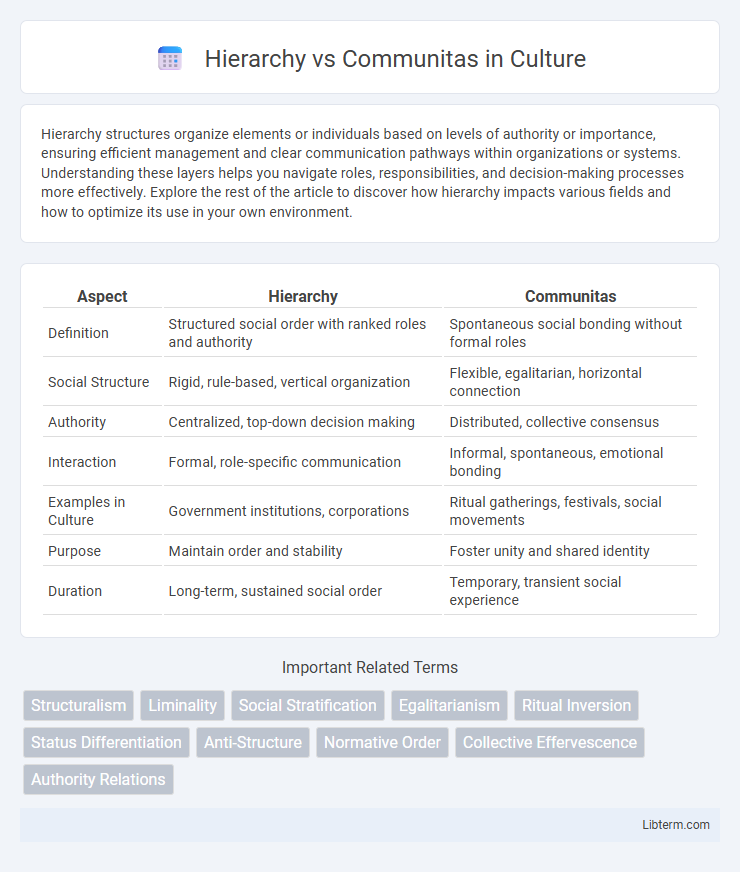Hierarchy structures organize elements or individuals based on levels of authority or importance, ensuring efficient management and clear communication pathways within organizations or systems. Understanding these layers helps you navigate roles, responsibilities, and decision-making processes more effectively. Explore the rest of the article to discover how hierarchy impacts various fields and how to optimize its use in your own environment.
Table of Comparison
| Aspect | Hierarchy | Communitas |
|---|---|---|
| Definition | Structured social order with ranked roles and authority | Spontaneous social bonding without formal roles |
| Social Structure | Rigid, rule-based, vertical organization | Flexible, egalitarian, horizontal connection |
| Authority | Centralized, top-down decision making | Distributed, collective consensus |
| Interaction | Formal, role-specific communication | Informal, spontaneous, emotional bonding |
| Examples in Culture | Government institutions, corporations | Ritual gatherings, festivals, social movements |
| Purpose | Maintain order and stability | Foster unity and shared identity |
| Duration | Long-term, sustained social order | Temporary, transient social experience |
Understanding Hierarchy and Communitas
Hierarchy structures organize individuals based on ranked levels of authority, ensuring clear roles and decision-making channels that promote order and efficiency in organizations and societies. Communitas emphasizes egalitarian bonds and shared experiences, fostering deep social connections and collective identity beyond formal roles or status. Understanding hierarchy involves recognizing power dynamics and formal responsibilities, while communitas highlights the importance of spontaneous, inclusive social unity and emotional solidarity.
Historical Roots of Hierarchy
The historical roots of hierarchy trace back to ancient societies where structured levels of authority ensured social order and resource distribution, exemplified by feudal systems in medieval Europe and caste systems in ancient India. Hierarchies often emerged from the need to manage large populations, enforce laws, and coordinate complex economic activities. This contrasts sharply with communitas, which originates from rites of passage and communal bonding in tribal cultures emphasizing egalitarian social relations.
Origins and Meaning of Communitas
Communitas originates from anthropologist Victor Turner's studies of ritual and social structures, referring to an intense community spirit and equal social relationships that emerge during liminal phases of rites of passage. Unlike hierarchy, which is characterized by structured, ranked, and authority-based social organization, communitas represents an anti-structure, emphasizing shared experience, collective unity, and the breakdown of social distinctions. The concept highlights moments in social life when individuals temporarily transcend formal roles, fostering a sense of belonging and human equality.
Core Differences: Structure vs. Spontaneity
Hierarchy emphasizes structured roles, clear authority, and organized systems that maintain order and predictability within groups or organizations. Communitas arises through spontaneous, egalitarian interactions fostering solidarity and shared experiences without formal constraints or rigid roles. The core difference lies in hierarchy's reliance on established frameworks versus communitas' embrace of fluid, collective participation.
Social Dynamics in Hierarchical Systems
Social dynamics in hierarchical systems are characterized by structured roles, clear authority lines, and defined responsibilities that maintain order and predictability within groups or organizations. Power distribution follows a top-down approach where decision-making concentrates at higher levels, reinforcing status differences and systematic control. This contrasts with communitas, which emphasizes egalitarian interactions and shared experiences that temporarily dissolve hierarchical distinctions for collective unity.
Communitas in Modern Organizations
Communitas in modern organizations fosters a sense of shared purpose and equality, breaking down traditional hierarchical barriers to encourage collaboration and innovation. It emphasizes collective engagement and emotional bonding among employees, promoting inclusive cultures that enhance creativity and adaptability. This approach often results in higher employee satisfaction and stronger organizational commitment compared to rigid hierarchical structures.
Benefits and Limitations of Hierarchy
Hierarchy structures enable clear authority lines and streamlined decision-making processes, improving organizational efficiency and accountability. However, rigid hierarchies can hinder innovation and reduce employee autonomy, potentially leading to decreased motivation and slower adaptation to change. Despite promoting order and predictability, hierarchical systems may limit collaboration and suppress diverse perspectives essential for dynamic problem-solving.
Strengths and Challenges of Communitas
Communitas fosters strong social bonds and a sense of equality by encouraging spontaneous, collective experiences that break down traditional hierarchies. Its strength lies in promoting inclusivity and shared identity, enhancing group cohesion and emotional connection. Challenges include maintaining structure and long-term sustainability, as the lack of formal organization can lead to ambiguity and potential conflict within the group.
Case Studies: Real-world Applications
Case studies in organizational behavior reveal that hierarchy structures enable clear decision-making pathways and accountability in corporations like Toyota, enhancing operational efficiency. In contrast, community-driven models such as those seen in the Mondragon Corporation foster strong employee engagement and social cohesion through cooperative ownership. Both frameworks demonstrate unique advantages in scalability and innovation based on contextual application.
Navigating Between Hierarchy and Communitas
Navigating between hierarchy and communitas requires balancing structured authority with spontaneous social bonding to foster effective collaboration and innovation. Hierarchy provides clear roles and decision-making pathways, while communitas encourages shared experiences and egalitarian connections that enhance team cohesion. Successfully integrating these dynamics allows organizations to maintain order while promoting creativity and mutual support.
Hierarchy Infographic

 libterm.com
libterm.com